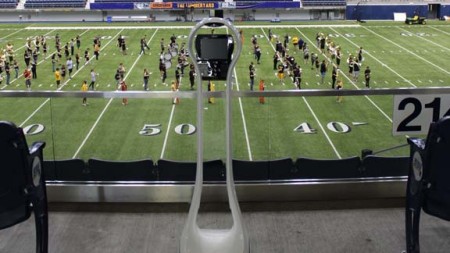
The Mayo Clinic is testing the feasibility of using a telemedicine robot during football games to assess athletes with suspected concussions.
With sophisticated robotic technology, use of a specialized remote controlled camera system allows patients to be “seen” by the neurology specialist, miles away, in real time. During this research study, the robot is equipped with a specialized camera system remotely operated by a Mayo Clinic neurologist located in Phoenix who has the ability to assess a player for symptoms and signs of a concussion and to consult with sideline medical personnel.
The robot was first used in a game during the Lumberjacks season opener on Aug. 30 against the University of Arizona in Tucson.
“Athletes at professional and collegiate levels have lobbied for access to neurologic expertise on the sideline,” said Bert Vargas, a neurologist at Mayo Clinic who is heading up the research. “As we seek new and innovative ways to provide the highest level of concussion care and expertise, we hope that teleconcussion can meet this need and give athletes at all levels immediate access to concussion experts.”
This study is the first to explore whether a remote neurological assessment is as accurate as a face-to-face evaluation in identifying concussion symptoms and making return-to-play decisions. Mayo Clinic physicians will not provide medical consultations during the study, they only will assess the feasibility of using the technology. If it appears feasible, this may open the door for countless schools, athletic teams and organizations without access to specialized care to use similar portable technology for sideline assessments.
“As nearly 60 percent of U.S. high schools do not have access to an athletic trainer, youth athletes—who are more susceptible to concussion and its after-effects—have the fewest safeguards in place to identify possible concussion signs and symptoms at the time of injury,” Vargas said. “Teleconcussion is one way to bridge this gap, regardless of when or where they may be playing.”
Others involved in collegiate sports agree.
“At NAU, our primary goal is to provide an outstanding student-athlete experience culminating in graduation,” said Lisa Campos, vice president for Intercollegiate Athletics. “We charge our staff to research the most current and best practices to ensure the safety and care of our students. Partnering with the Mayo Clinic in its telemedicine study will further this research and potentially improve diagnosis for rural areas that may not have access to team doctors or neurologists.”
She also said the study will allow the NAU sports medicine staff and team doctors to continue making all diagnoses and return-to-play decisions for its students while investigating the effectiveness and efficiencies of telemedicine.
Ramogi Huma, executive director of the National College Players Association, said there were a number of examples last football season in which college football players demonstrating concussion-like symptoms were “quickly” thrown back in games or weren’t taken out of the game for an evaluation. “College football players are in desperate need for independent concussion experts on the sidelines, and this study could help make that safeguard a reality,” Huma said.



